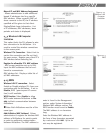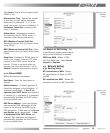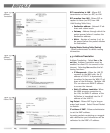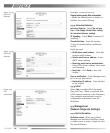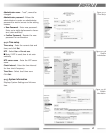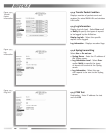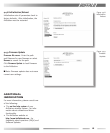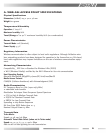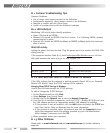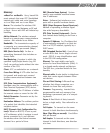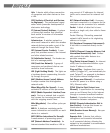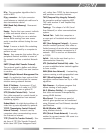
22
23
Glossary
10BaseT or 100BaseTx: 802.3 based Eth-
ernet network that uses UTP (Unshielded
twisted pair) cable and a star topology.
10 is 10 Mbps and 100 is 100 Mbps.
802.1x: The standard for wireless LAN
authentication used between an AP and
a client. 802.1x with EAP will initiate key
handling.
Ad-Hoc Network: The wireless network
based on a peer-to-peer communications
session. Also referred to as AdHoc.
Bandwidth: The transmission capacity of
a computer or a communication channel,
stated in Megabits per second (Mbps).
BSS (Basic Service Set): An 802.11
networking framework that includes an
Access Point.
Bus Mastering: A system in which the
specied Input/Output device (e.g. NIC
Card) can perform tasks without the inter-
vention of the CPU.
Client: A PC or workstation on a network.
Cross-Over Wiring: A UTP cable that has
its transmit and receive pair crossed
to allow communications between two
devices.
DCE (Data Communications Equipment):
Hardware used for communication with a
Data Terminal Equipment (DTE) device.
Default Gateway: The IP Address of either
the nearest router or server for the LAN.
Default Parameter: Parameter set by the
manufacturer.
Destination Address: The address portion
of a packet that identies the intended
recipient station.
DHCP (Dynamic Host Conguration Pro-
tocol): Based on BOOTP, it uses a pool
of IP addresses, which it assigns to each
device connected to it, and retrieves
the address when the device becomes
dormant for a period of time.
DNS (Domain Name System): System
used to map readable machine names
into IP addresses
Driver: Software that interfaces a com-
puter with a specic hardware device.
DSSS (Direct Sequence Spread Spectrum):
Method of spreading a wireless signal
into wide frequency bandwidth.
DTE (Data Terminal Equipment): Device
that controls data owing to and from a
computer.
Dynamic IP Address: An IP address that
is automatically assigned to a client sta-
tion in a TCP/IP network, typically by a
DHCP server.
ESS (Extended Service Set): A set of two
or more BSSs that form a single sub-net-
work. ESS-ID is user identication used
in the ESS LAN conguration.
Ethernet: The most widely used archi-
tecture for Local Area Networks (LANs). It
is a shared-media network architecture.
The IEEE 802.3 standard details its func-
tionality.
Ethernet cable: A wire similar to telephone
cable that carries signals between Ether-
net devices.
File and Print Sharing: A Microsoft ap-
plication that allows computers on a
network to share les and printers.
Firmware: Programming inserted into
programmable read-only memory, thus
becoming a permanent part of a comput-
ing device.
Frame: A xed block of data, transmit-
ted as a single entity. Also referred to as
packet.
Full-Duplex: To transmit on the same
channel in both directions simultaneously.
Gbps (Giga Bits per second): One billion
bits per second.
Half-duplex: To transmit on the same
channel in both directions, one direction
at a time.




